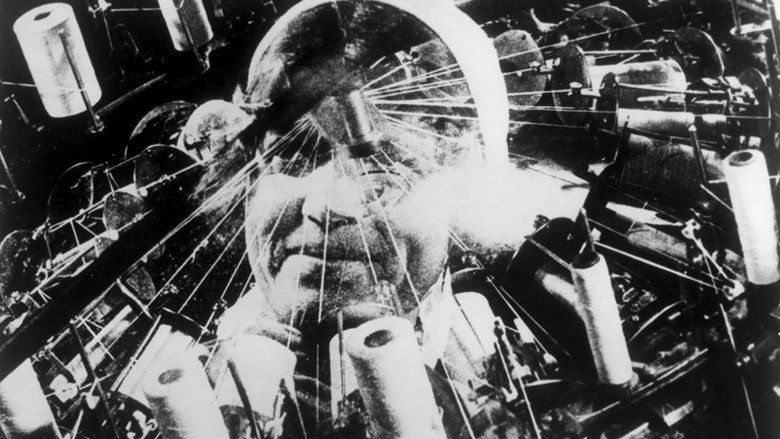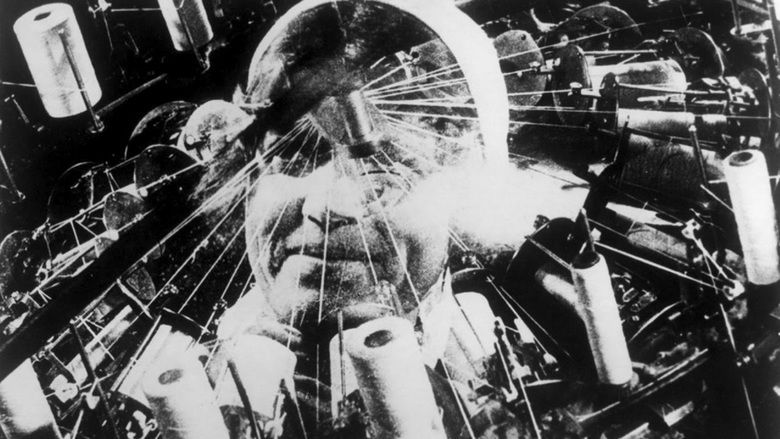Man with a Movie Camera
9.4 /10 1 Votes
4/4 Roger Ebert Initial DVD release May 31, 2006 (Russia) Duration | 8.4/10 IMDb 96% Rotten Tomatoes Genre Documentary | |||||||||||||||||||||||||||||||||
 | ||||||||||||||||||||||||||||||||||
Release date 8 January 1929 (1929-01-08) Similar movies Dziga Vertov directed Man with a Movie Camera and A Sixth Part of the World | ||||||||||||||||||||||||||||||||||
Voxare meets the man with a movie camera trailer
Man with a Movie Camera (Russian: Человек с кино-аппаратом (Chelovek s kinoapparatom), Ukrainian: Людина з кіноапаратом (Liudyna z Kinoaparatom) – sometimes called A Man with a Movie Camera, The Man with the Movie Camera, The Man with a Camera, The Man with the Kinocamera, or Living Russia) – is an experimental 1929 Soviet silent documentary film, directed by Dziga Vertov and edited by his wife Elizaveta Svilova.
Contents
- Voxare meets the man with a movie camera trailer
- Man with a movie camera 1929 movie
- Overview
- Vertovs intentions
- Stylistic aspects
- Production
- Initial
- Reevaluation
- Analysis
- Soundtracks
- References

Vertov's feature film, produced by the film studio VUFKU, presents urban life in the Soviet cities of Kiev, Kharkov, Moscow and Odessa. It has no actors. From dawn to dusk Soviet citizens are shown at work and at play, and interacting with the machinery of modern life. To the extent that it can be said to have "characters," they are the cameramen of the title, the film editor, and the modern Soviet Union they discover and present in the film.

Man with a Movie Camera is famous for the range of cinematic techniques Vertov invents, deploys or develops, such as double exposure, fast motion, slow motion, freeze frames, jump cuts, split screens, Dutch angles, extreme close-ups, tracking shots, footage played backwards, stop motion animations and self-reflexive visuals (at one point it features a split-screen tracking shot; the sides have opposite Dutch angles).

Man with a Movie Camera was largely dismissed upon its initial release; the work's quick-cut editing, self-reflexivity, and emphasis on form over content were all subjects of criticism. In the British Film Institute's 2012 Sight & Sound poll, however, film critics voted it the eighth greatest film ever made, and the work was later named the best documentary of all time in the same magazine.

Man with a movie camera 1929 movie
Overview
The film has an unabashedly avant-garde style, and emphasizes that film can go anywhere. For instance, the film uses such scenes as superimposing a shot of a cameraman setting up his camera atop a second, mountainous camera, superimposing a cameraman inside a beer glass, filming a woman getting out of bed and getting dressed, even filming a woman giving birth, and the baby being taken away to be bathed.
Vertov's message about the prevalence and unobtrusiveness of filming was not yet true—cameras might have been able to go anywhere, but not without being noticed; they were too large to be hidden easily, and too noisy to remain hidden anyway. To get footage using a hidden camera, Vertov and his brother Mikhail Kaufman (the film's co-author) had to distract the subject with something else even louder than the camera filming them.
The film also features a few obvious stagings such as the scene of a woman getting out of bed and getting dressed and the shot of chess pieces being swept to the center of the board (a shot spliced in backwards so the pieces expand outward and stand in position). The film was criticized for both the stagings and the stark experimentation, possibly as a result of its director's frequent assailing of fiction film as a new "opiate of the masses."
Vertov's intentions
Vertov — born David Abelevich Kaufman — was an early pioneer in documentary film-making during the late 1920s. He belonged to a movement of filmmakers known as the kinoks, or kino-oki (kino-eyes). Vertov, along with other kino artists declared it their mission to abolish all non-documentary styles of film-making. This radical approach to movie making led to a slight dismantling of film industry: the very field in which they were working. Most of Vertov's films were highly controversial, and the kinok movement was despised by many filmmakers of the time. Vertov's crowning achievement, Man with a Movie Camera, was his response to critics who rejected his previous film, A Sixth Part of the World. Critics had declared that Vertov's overuse of "intertitles" was inconsistent with the film-making style to which the 'kinoks' subscribed.
Working within that context, Vertov dealt with much fear in anticipation of the film's release. He requested a warning to be printed in the Soviet central Communist newspaper, Pravda, which spoke directly of the film's experimental, controversial nature. Vertov was worried that the film would be either destroyed or ignored by the public. Upon the official release of Man with a Movie Camera, Vertov issued a statement at the beginning of the film, which read:
"The film Man with a Movie Camera represents
AN EXPERIMENTATION IN THE CINEMATIC COMMUNICATION
Of visual phenomena
WITHOUT THE USE OF INTERTITLES
(a film without intertitles)
WITHOUT THE HELP OF A SCENARIO
(a film without a scenario)
WITHOUT THE HELP OF THEATRE
(a film without actors, without sets, etc.)
This manifesto echoes an earlier one that Vertov wrote in 1922, in which he disavowed popular films he felt were indebted to literature and theater.
Stylistic aspects
Working within a Marxist ideology, Vertov strove to create a futuristic city that would serve as a commentary on existing ideals in the Soviet world. This artificial city’s purpose was to awaken the Soviet citizen through truth and to ultimately bring about understanding and action. The kino’s aesthetic shined through in his portrayal of electrification, industrialization, and the achievements of workers through hard labour. This could also be viewed as early modernism in film.
Some have mistakenly stated that many visual ideas, such as the quick editing, the close-ups of machinery, the store window displays, even the shots of a typewriter keyboard are borrowed from Walter Ruttmann's Berlin: Symphony of a Great City (1927), which predates Man with a Movie Camera by two years, but as Vertov wrote to the German press in 1929, these techniques and images had been developed and employed by him in his Kino-Pravda newsreels and documentaries for the last ten years, all of which predate Berlin. Vertov's pioneering cinematic concepts actually inspired other abstract films by Ruttmann and others, including writer, translator, filmmaker and critic Liu Na'ou (1905–1940) whose The Man Who Has a Camera (1933), pays explicit homage to Vertov's The Man With a Movie Camera.
On a technical note, Man with a Movie Camera's usage of double exposure and seemingly 'hidden' cameras made the movie come across as a very surreal montage rather than a linear motion picture. Many of the scenes in the film contain people, which change size or appear underneath other objects (double exposure). Because of these aspects, the movie is fast-moving. The sequences and close-ups capture emotional qualities, which could not be fully portrayed through the use of words. The film's lack of 'actors' and 'sets' makes for a unique view of the everyday world; one that, according to a title card, is directed toward the creation of a new cinematic language that is "[separated] from the language of theatre and literature."
Production
Man with a Movie Camera, depicting the daily life of a Soviet city, was actually filmed over a period of about 3 years. Four Soviet cities — Kharkiv, Kiev, Moscow and Odessa — were the shooting locations.
Initial
Man with a Movie Camera was not always a highly regarded work. Vertov's Soviet contemporaries criticized its focus on form over content, with Sergei Eisenstein even deriding the film as "pointless camera hooliganism". The work was largely dismissed in the West as well. Documentary filmmaker Paul Rotha said that in Britain, Vertov was "regarded really as rather a joke, you know. All this cutting, and one camera photographing another camera – it was all trickery, and we didn't take it seriously." The pace of the film's editing — more than four times faster than a typical 1929 feature, with approximately 1,775 separate shots — also perturbed some viewers, including The New York Times' reviewer Mordaunt Hall:
"The producer, Dziga Vertov, does not take into consideration the fact that the human eye fixes for a certain space of time that which holds the attention."Because of doubts before screening, and great anticipation from Vertov's pre-screening statements, the film gained great interest before even being shown. Once the film was finally screened, the public either embraced or dismissed Vertov's stylistic choices.
Reevaluation
Man with a Movie Camera is regarded as one of the greatest films ever made, having ranked eighth in the 2012 Sight & Sound poll of the world's best films. In 2009, Roger Ebert wrote, "It made explicit and poetic the astonishing gift the cinema made possible, of arranging what we see, ordering it, imposing a rhythm and language on it, and transcending it."
Analysis
Man with a Movie Camera has been interpreted as an optimistic work. Jonathan Romney has called it "an exuberant manifesto that celebrates the infinite possibilities of what cinema can be." Peter Bradshaw of The Guardian wrote that the work "is visibly excited about the new medium’s possibility, dense with ideas, packed with energy: it echoes Un Chien Andalou, anticipates Vigo's À propos de Nice and the New Wave generally, and even Riefenstahl's Olympia."
Soundtracks
The film, originally released in 1929, was silent, and accompanied in theaters with live music. It has since been released a number of times with different soundtracks:
References
Man with a Movie Camera WikipediaMan with a Movie Camera IMDbMan with a Movie Camera Roger EbertMan with a Movie Camera Rotten TomatoesMan with a Movie Camera themoviedb.org
